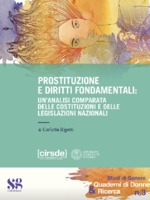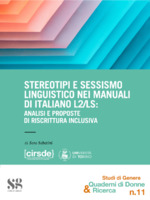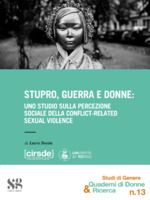Sfoglia documenti (13 in totale)
- Collezione: Studi di Genere. Quaderni di Donne & Ricerca
Sort by:
Prostituzione e diritti fondamentali: un'analisi comparata delle costituzioni e delle legislazioni nazionali
Lo scritto analizza i modelli legislativi esistenti in materia di prostituzione sul panorama europeo, soffermandosi su quei delicati profili giuridici inerenti il bilanciamento dei diritti fondamentali racchiusi nelle singole Costituzioni nazionali. In particolare l'analisi riguarda l'ordinamento russo, svedese, italiano e tedesco, che rispettivamente riflettono il proibizionismo, il neoproibizionismo, l'abolizionismo e la regolamentazione della prostituzione.
The work deals with the existing relationship between prostitute's fundamental rights and all the legal frameworks which are in force in Europe.
Chapter I examines some legal, thorny issues concerning prostitution, such as the disposal of the body, the notion of human dignity, the equality principle, the general clause of good customs, the right to work and to health and. In Chapters II-V these issues are transposed into the analysis of four European States' Constitution and legislations.
The Russian prohibitionism is characterised by the prostitutes' administrative prosecution on the basis of public morality and health.
The Swedish neo-prohibitionism aims at establishing a gender policy, which is grounded on a new social order; as a result, Swedish law subjects clients to sanctions, while considering prostitutes as victims who deserve a special protection.
Italian abolitionism provides for a freedom to prostitute yourself which must be in compliance with the general clause of public morality, while prosecuting all those activities that are ancillary and apt to violate the prostitutes' self-determination; in any case, the legislative aim is to respect and fulfil all the constitutional fundamental rights.
The German regulatory framework regards prostitution as an expression of the occupational freedom provided by the Basic Law, in order to promote the individual's substantial self-determination and to protect prostitutes' fundamental rights.
Finally the work ends with a short consideration on whether there is - or there is not - a legal pattern which is apt to protect all the fundamental rights to whom prostitutes are entitled.
Stereotipi e sessismo linguistico nei manuali di italiano L2/LS: analisi e proposte di riscrittura inclusiva
The work aims at a reconnaissance of the current teaching material used in classes of Italian as a foreign language, bearing in mind the perspective of gender inclusive language and gender stereotypes.
A detailed linguistic analysis of copiuous textbooks – which was carried out upholding the approach of Italian linguist Alma Sabatini - highlights how the female world is still shaped through a male-dominant point of view. As a matter of fact, linguistich inclusivity often fails to be achieved, falling the Italian language into the grammatical gender languages type. The purpose of the analysis present in Chapter 3 is to show how a gender sensitive linguistic approach can be obtained and integrated into foreing language teaching material of Italian language, catering to all six level of the CEFR (Common European Framework of Reference for Languages) through degendering and engendering strategies.
On the other hand, the ambition of shaping multicultural beings across the world calls for the analysis of the socio-cultural aspects representing Italy in the aforementioned textbooks. This analysis (Chapter 4) recognizes five areas in which gender stereotypes, regarding the female sphere, are strongly pervasive and fail to represent the actual nuaces of life and personal identity - childhood, labour, family care, housekeeping, and physical appearence.
Lastly, Chapter 5 argues the outcomes of both the linguistic and socio-culultural analysis, in view of a future improvement of such teaching materials.
Stupro, guerra e donne: uno studio sulla percezione sociale della conflict-related sexual violence
War has been, and still is, highly characterized by sexual violence. The present work takes a cue from the testimonies of victims of Conflict-Related Sexual Violence narrated by Lamb (2020) in “Our Bodies, Their Battlefield: What war does to Women” since, as the author writes, “You won’t find these women’s names in the history books or on the war memorials that we pass in our railway stations and town centres but to me, they are the real heroes.” (p.11).
Although war rape has existed for as long as conflicts themselves have existed, the legislative relevance of this crime as a crime against humanity, as a weapon of genocide, and as a war crime, only came into existence following the establishment of ad hoc international criminal tribunals for the former Yugoslavia and Rwanda.
Understanding the origin of sexual violence in armed conflicts is very complex as it is the result of multiple variables: from cultural norms to complex political and war strategies. Rape is often committed to terrorizing the population, breaking up families, destroying communities and even changing the ethnic composition of the next generations.
Many studies have focused on the socio-political analysis of this reality and the consequences at individual, social, and community levels. Few, however, have investigated the social perception of this issue. The main purpose of this exploratory research is to investigate whether people's perception of sexual violence can be influenced and modified by the war context in which this violence occurs, since, as Frese and colleagues (2004) point out, the characteristics of the context in which the violence occurred influence the participant’s perception of the event. In particular, the focus was on the recognition of the event as violence, the perception of severity, and the punitiveness of the perpetrators.



